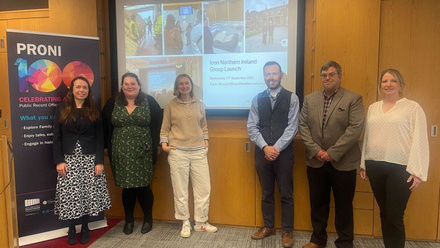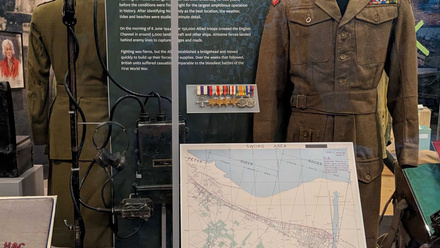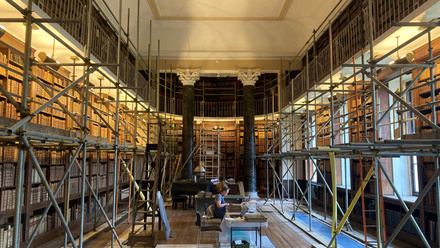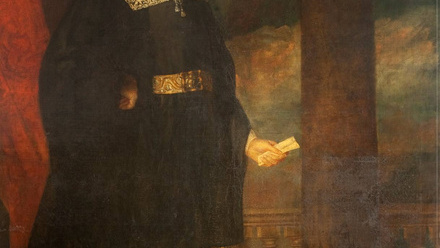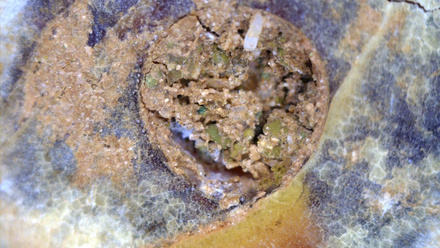Sustainable Museum Lighting Q&A
Guidelines for climatic conditions for collections have frequently been revised to balance better the environmental needs of collections and the energy consumption required to achieve these conditions. Because it represents a lesser proportion of energy usage, lighting has often been a secondary consideration. When the sustainability of lighting is considered, it has largely been a matter of reducing the cost of electric lighting, through decreased energy use and less frequent lamp replacement.
Icon Environmental Sustainability Network (ESN) hosted a Sustainable Museum Lighting webinar on 2 February 2021, which explored how current and new lighting and control technologies and practices can be assessed in relation to a number of different measures of sustainability. The event included a Q&A Session with Dr. David Saunders. The questions asked during the webinar and Dr. Saunders's answers can be read below:
Q1. Would you say there is a difference in the chemical impact to materials taking the same amount of lux from a LED light and other kinds of lighting technologies? For example, do 50 lux have the same chemical effects on the object when talking about LED or fluorescent light? (leaving the factor of the UV outside, by filtering the fluorescent for instance)
There are some differences between the amount of damage caused by lamps using the same technology that operate at different colour temperatures (on average, lamps with a higher colour temperature are more likely to cause damage). There is some evidence emerging that LED lamps may cause a little less damage than other light sources (incandescent, fluorescent, etc.) with the same colour temperature. It is important to remember however, that individual materials may not follow these general patterns.
Q2. In terms of daylight, have you looked at windows have photovoltaics included that produce some electricity?
A short answer is no. I am aware that it is gaining increasing popularity in domestic architectural solutions, but one issue with using photovoltaic glass in museums is that we are – potentially – already asking rather a lot from our outer glazing layer: ultraviolet rejection, thermal gain reduction (see later answer), good colour properties and perhaps some degree of shading. I am not sure to what extent the introduction of the photovoltaic layer into our glazing systems would be compatible with these other properties – but I am not an architect or engineer!
Q3. We often have to run a new wiring for lighting control, and it can be very expensive and some fittings are only compatible with certain system. Do you know whether the industry might be heading towards wire-less so that less impact on existing fabric and possibly more sustainable?
Yes, there is a move towards wireless control, for example through Bluetooth, but I am not sure how quickly this will extend widely into museum settings. If wired lighting control is anything to go by, there is also no guarantee that future systems will all use the same protocols. It is worth bearing in mind that while wireless control might help sustain the historic fabric of a building, it may consume considerable energy and its operation may be complex and require specific expertise not always present in smaller organisations.
Q4. Lambeth Palace Library has just built a sustainable space for collection storage, access and staffing. We left a small space aside to eventually turn into an exhibition space but now we seem to be ready to start turning this blank canvas into our new museum. We have the original build contractors developing this space, who although have created sustainable buildings (and are really good at this) have not completed a museum before. They have a large amount of information from us already but if you were invited to the first design delivery meeting, what would you advise as the fundamentals, to ensure we could reach sustainability targets alongside applying current museum standards?
I would first map out the ‘what’, then the ‘how’. On the former my usual advice is to know your collection, your visitors and your mind. Think about the collection material that will be displayed and its vulnerability to different environmental parameters: use your experience and that from others to be specific about this, don’t just assume a worst case. Think about who will visit. How many people can you accommodate, what is their likely effect on the space, and what are their needs for viewing and comfort. Think about what you want to achieve – how long would you like to be open, how long will particular collection material be on display, how long do you want the collections to remain unchanged? Then balance any conflicting ‘ambitions’ within this framework to arrive at a solution that balances social and societal sustainability. Then look at how to apply environmentally, operationally and fiscally sustainable systems to the running of the space, as envisaged by the first phase, revisiting those decisions if it is clear that any create requirements that acutely affect these three measures of sustainability.
Q5. LED‘s seem to produce more glare than other lighting sources, probably because the light source is right at the front of the fixture. Museum lighting designers must take this, into account, especially when designing in-case lighting, making sure the LED itself is blocked from view.
I agree that it is more a function of luminaire design than an intrinsic issue with LEDs. Their very small size makes it possible to place them more-or-less anywhere, so good lamp positioning and lighting design are – as you say – crucial.
Q6. How expensive is electro chromic shading? I presume this shades the windows according to the lux levels?
The cost of system will depend on the type used. The electrochromic film that I showed – used at Hampton Court Palace by colleagues in Historic Royal Palaces – is at the less expensive end of the market, but so-called smart glass is much more costly (I am afraid I do not have figures). These are electrochromic not photochromic products, so they do not react to light levels but to the application of an electric current. If a photocell is used to generate that current, they will respond to light, but the film or glass can also be darkened in response to other events (such as detecting that there is no one in a room and reducing the light level accordingly).
Q7. Is there any conservation issue related to the use of ‘switching of lights responding to the presence of visitors’? Any negative effects on the objects?
I cannot think of any negative effects on the object of switching off the lights in absence of visitors: this reduces energy consumption and contributes to extending the lifetime of objects that are vulnerable to light damage. If a system based on sensing visitors is used, some care is needed to make sure that it does not switch the lights off just because the visitor is not moving.
Q8. With daylight lighting one of the concerns has been the heat produced through solar gain and the cost of cooling because of it. Has there been much done on the costing for this? In practice, I've not found manual blinds to be very effective unless it is actively managed by conservation or museum management.
Heat gain from daylight can be an issue – and another reason why some museums simply opt for its exclusion. But heat rejecting glazing (sometimes called low-E glass) is now widespread and can contribute both to rejecting solar gain and heat retention
by a building. Your point about the need to manage the control of manual blinds well illustrates the need to consider operational sustainability. Linking these two points, external blinds or louvres for light control have the added benefit of rejecting rather more heat, but are generally less easily controlled manually.
Q9. Any notion of conflict free used material to be included in sustainability societal goals?
Very good question. A number of lighting suppliers already have statements on their websites regarding their due diligence processes to avoid the use of conflict minerals. These are generally regarded as the metal or ores of tantalum, tungsten, tin and gold (sometimes called 3TG). In the US, outlawing conflict minerals forms a part of wider legislation enacted in 2010. The EU has also long recommended due diligence on sourcing these materials, with new regulations coming into force on 1 January 2021.
Q10. Your talk focused on internal lighting at museums. What about external lighting, that has major implications for energy use and also environmental considerations, attracting wildlife and insects, contributing to biodiversity decline. It looks like changing the spectra to reduce the blue content of light at night helps minimize this impact. Is this a consideration museums are taking into account?
While a good point, it is not something I have considered other than the potential for energy conservation by reducing the level of exterior lighting (if any is needed), limiting the length of time for which is it active each evening/night, and remembering that if a timer is used, it ought to adjust to seasonal changes in the length of the day. I have not looked into the effect of exterior lighting on biodiversity, but it may be that illumination rich in blue light, which suppresses melatonin production and thus affects the circadian cycles in many creatures will be a factor.
Q11. Maybe this question regards more on everyday lightning for our homes, but I will ask anyway. What is an impact of white LED light on our health?
I do not think that there any health concerns from LED lamps that would not arise from other types of source. Two factors that are often cited are: ultraviolet output and its potential detrimental effects on eyes or skin (LEDs have a generally very low output compared to other sources of light – particularly daylight); and blue light emission disrupting circadian rhythms of sleep and wakefulness (while some LEDs might produce ‘bluer’ light, the same could be said for some fluorescent lamps, so it becomes a matter of selecting lamps that do not have this property). There is also the question of flicker, which might affect some people, but other lamps can show flicker and it can be as much related to the control system as the lamp.
Q12. For which kind of objects were conservation aspects of LED lighting evaluated? Might there be any drawbacks instead for certain materials?
Surprisingly, given the huge uptake of LED lamps, there has not been a great deal of research into their effects on different material classes. Indeed, many of the studies of relative damage are based on theoretical calculations that use damage functions developed in the 1980s and 1990s in Berlin. Some studies have looked at the fading of blue wool standards, but we know that these do not necessarily behave in quite the same manner as the materials we find in cultural heritage collections. There is definitely a need for some further research here once we can get back into labs!
Q13. I am not sure, but I am curious if electric costs for artificial lighting in museum is not lower than electric functioning complex shades?
It is certainly worth making this comparison, looking at the energy consumption by motors compared to lamps. However, although the wattage of a motor may be greater than that of a LED, there are likely to be fewer motors than lamps in a room and the motors are likely to run for only a number of minutes each day, compared to hours for the lamps.
Q14. What do you think the biggest challenge is in communicating the switch to more sustainable practices in lighting?
I suspect that the nature of the challenge depends on to whom you are trying to communicate and whether by communicate you actually mean convince. There might be the need to demonstrate that initial costs of a move to more sustainable lighting will produce longer term savings (as well as improving the institution’s green profile) or to reassure others that sustainability is compatible – or largely compatible – with other criteria, such as high quality display of the collection or its long term preservation.
Q15. Is there any information on types of LEDs best for galleries and museum settings?
I hesitate to be specific here, because the development of new LEDs is so rapid. Good resources for decision making include Jim Druzik and Stefan Michalski’s 2012 Guidelines for Selecting Solid-State Lighting for Museums and – from 2020 – the same authors’ more recent LED Lighting in Museums and Art Galleries – Technical Bulletin 36.
Q16. Would you have any specific thoughts on using fibre optic style lighting? Are specific LED bulbs perhaps preferable in terms of creating simpler lighting setups?
Fibre optic systems enjoyed strong popularity in the 1990s and 2000s as a means of delivering light to a number points without the need to place a light source at each of those positions. To an extent, the extremely small size of LEDs has provided an alternative to the use of fibre optic systems, although the latter still offer certain advantages, such as moving a potential source of heat and fire away from the area in which objects are displayed— a particular advantage in display cases. The optics of a fibre optic projector imply that an LED light source that is capable of being focused onto the rather small entry aperture for the fibre will be needed.
Q17. How much energy is used in turning on lights when necessary for viewing?
This is not really an issue. Even in the worst case – certain (now rather outdated) fluorescent lamps – the energy consumed by switching a light on equates to only a few seconds of running.
Q18. Do the colour temperatures of LEDs and other lightings correspond well? For example, if we have the galleries lit with tungsten @ 3500K and the conservation studio lit with LEDs @ 3500K?
The CCT of an LED at 3500K and an incandescent lamp at 3500 K will (by definition) be similar, but perhaps you are interested in whether the colour appearance under the two lamps will be similar and whether, therefore, this would present an issue for colour matching under the different lamps (metamerism). If both lamps have good colour rendering / colour fidelity, then mismatches should be rare.
Q19. You propose daylight but the consequences on some objects are enormous, is there a filter that can really reduce UV/heat?
Heat rejecting, or Low-E, glass is increasingly used to reduce solar gain in both domestic and public buildings. It rejects a high proportion of the infrared radiation and also blocks some ultraviolet. The latter is generally eliminated more completely by ensuring that a laminated glass with an interlayer that contains an ultraviolet absorbing polymer, such as polyvinyl butyrate (PVB), is incorporated into the glazing system.
Q20. I am very interested in the types of grants and available funds to do these sort of updates. Do you have any suggestions for small museums wanting to finance these sort of changes?
Such grants and funding will depend on location. In many countries national or regional grants are available to help organisations improve their energy efficiency and reduce their environmental impact. In the UK, Julie’s Bicycle has a section called ‘Funding Watch’ that contains details of grants that are available to museums and more widely in the arts sector.
Q21. What about impact of LEDs of certain colour temp on pigments - thinking of Van Gogh.
I presume you are referring to reports that circulated in 2013 about the potential effect of LED lamps – by virtue of their emission in the blue region – on pigments that strongly absorb violet/blue radiation, including chrome yellow, favoured by late nineteenth century artists including Van Gogh. Doubts were cast over the applicability of these results because the power of the radiation used in these studies
was enormous compared to that from an LED. That does not alter the fact that a source with a strong blue emission might be a little more damaging over the long term than one without, but other types of lamp, particularly fluorescents, also have peaks in this region. Moving to a lamp of lower colour temperature reduces the blue emission per lumen of visible light, so will tend to have less effect on materials that absorb, and are damaged by, blue wavelengths. Finally, some of the lamps about which most concerns were expressed in the 2013 study have since been superseded by those which have less potentially damaging blue/violet emissions.
Q22. Are there window glass filters that can reduce heat transmission from the sun without taking out light energy? (Obviously preferably with a UV filter)
A point was also made about the potential increase in temperature through solar gain as a result of a greater daylight inclusion. To reiterate, there are heat (infrared) rejecting films and glasses that can be used to reduce solar gain, often termed low-E glass, that do not remove too much visible light.
Q23. Two questions. 1. To achieve a 5 degree focused illumination which led lamp would you recommend using? 2. To achieve an LED light that respects the color range of the object, what could I use?
I hesitate to be specific here, because the development of new LEDs is so rapid. Good resources for decision making include Jim Druzik and Stefan Michalski’s 2012 Guidelines for Selecting Solid-State Lighting for Museums and – from 2020 – the same authors’ more recent LED Lighting in Museums and Art Galleries – Technical Bulletin 36.
Additional comment from Dr. Saunders:
The U.S. DOE published reports on the use of LEDs in museums including installations at the Smithsonian American Art Museum and The Getty. This is a valuable series of reports on the use of LEDs in museums that I neglected to mention in my talk.
Dr David Saunders
Honorary Research Fellow at the British Museum (previously Keeper of Conservation and Scientific Research 2005–2015). Principal Scientific Officer at the National Gallery 1985–2005. Visiting professor at the Institute for Sustainable Heritage, UCL since 2017 and the Conservation Center, NYU 2018. Guest scholar the Getty Conservation Institute 2015–16 and inaugural Getty/Rothschild Fellow at the Getty Research Institute and Waddesdon Manor in 2017. IIC Fellow, member of IIC Council and editor of Studies in Conservation 1990–2011. Research interests include the deterioration of museum objects, particularly by light, preventive conservation, and scientific examination of museum objects, especially non-invasive techniques.


